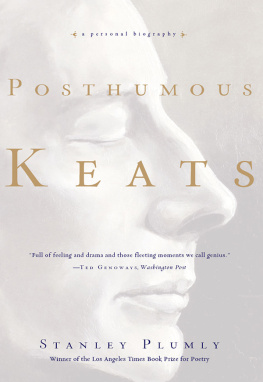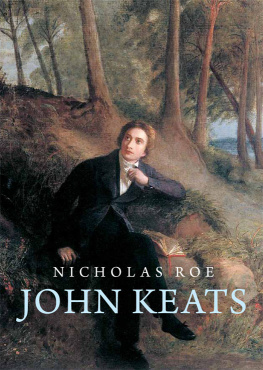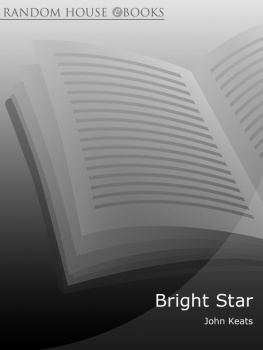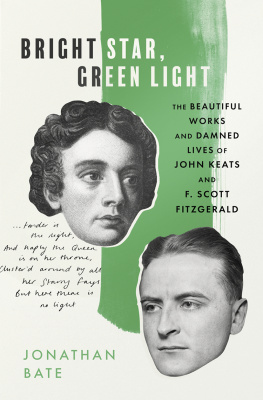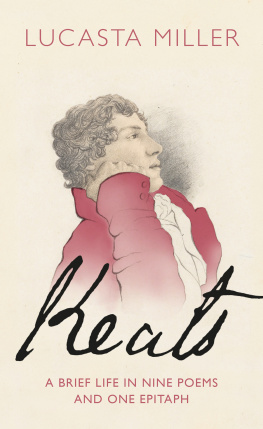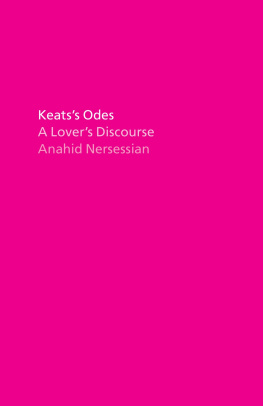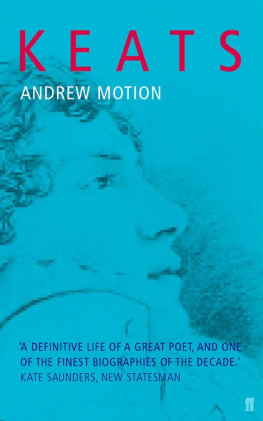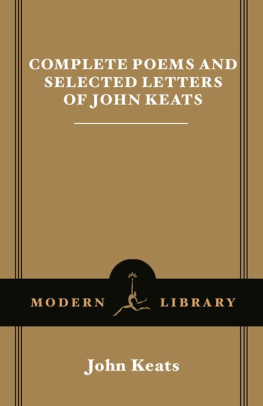Keats John - Posthumous Keats: a personal biography
Here you can read online Keats John - Posthumous Keats: a personal biography full text of the book (entire story) in english for free. Download pdf and epub, get meaning, cover and reviews about this ebook. City: New York, year: 2008, publisher: W. W. Norton & Company, genre: Detective and thriller. Description of the work, (preface) as well as reviews are available. Best literature library LitArk.com created for fans of good reading and offers a wide selection of genres:
Romance novel
Science fiction
Adventure
Detective
Science
History
Home and family
Prose
Art
Politics
Computer
Non-fiction
Religion
Business
Children
Humor
Choose a favorite category and find really read worthwhile books. Enjoy immersion in the world of imagination, feel the emotions of the characters or learn something new for yourself, make an fascinating discovery.
- Book:Posthumous Keats: a personal biography
- Author:
- Publisher:W. W. Norton & Company
- Genre:
- Year:2008
- City:New York
- Rating:3 / 5
- Favourites:Add to favourites
- Your mark:
- 60
- 1
- 2
- 3
- 4
- 5
Posthumous Keats: a personal biography: summary, description and annotation
We offer to read an annotation, description, summary or preface (depends on what the author of the book "Posthumous Keats: a personal biography" wrote himself). If you haven't found the necessary information about the book — write in the comments, we will try to find it.
Posthumous Keats: a personal biography — read online for free the complete book (whole text) full work
Below is the text of the book, divided by pages. System saving the place of the last page read, allows you to conveniently read the book "Posthumous Keats: a personal biography" online for free, without having to search again every time where you left off. Put a bookmark, and you can go to the page where you finished reading at any time.
Font size:
Interval:
Bookmark:
P OETRY
Old Heart
Now That My Father Lies Down Beside Me: New & Selected Poems, 19702000
The Marriage in the Trees
Boy on the Step
Summer Celestial
Out-of-the-Body Travel
Giraffe
How the Plains Indians Got Horses
In the Outer Dark
N ONFICTION
Argument & Song: Sources & Silences in Poetry
a personal biography
W. W. NORTON & COMPANY
new york london
Copyright 2008 by Stanley Plumly
All rights reserved
For information about permission to reproduce selections from this book, write to Permissions, W. W. Norton & Company, Inc., 500 Fifth Avenue, New York, NY 10110
Production manager: Julia Druskin
LIBRARY OF CONGRESS CATALOGING-IN-PUBLICATION DATA
Plumly, Stanley.
Posthumous Keats: a personal biography / Stanley
Plumly.1st ed.
p. cm.
Includes bibliographical references
ISBN: 978-0-393-07600-4
1. Keats, John, 17951821. 2. Keats, John, 17951821Influence. 3. Poets, English19th centuryBiography. I. Title.
PR4836.P68 2008
821'.7dc22
[B]
2008002681
W. W. Norton & Company, Inc.
500 Fifth Avenue, New York, N.Y. 10110
www.wwnorton.com
W. W. Norton & Company Ltd.
Castle House, 75/76 Wells Street, London W I T 3QT
For
WILLIAM MATTHEWS
VERSIONS OF THE FIRST THREE CHAPTERS WERE PUBLISHED in TriQuarterly (On He Flared), The Virginia Quarterly Review (Cold Pastoral), and The Kenyon Review (This Mortal Body). Thanks are due the editors. Versions of parts of the chapter Season of Mists first appeared in sections of Argument & Song: Sources & Silences in Poetry (2003).
Very special thanks to Megan Riley and Elizabeth Countryman, whose help in the preparation of this book was invaluable.
Also special thanks to Christina Gee and Roberta Davis, stalwarts of the Keats House, without whose help the making of this book would have been impossible.
To Jill Bialosky, Evan Carver, and Paul Whitlatch, my editors at Norton, admiration and warmest appreciation.
To friends Michael Collier, Howard Norman, and David Wyatt, steadfast and true, my greatest thanks.
To Daniel Halpern, whose patience and support have mattered most, my heartfelt thanks.
And to Deborah Digges a debt of gratitude for introducing me to Keatss Letters by quoting whole passages from memory.
And appreciation to Hawthornden Castle, the Bellagio Study and Conference Center, and the University of Maryland for their support.
We with our bodily eyes see but the fashion and Manners of one country for one ageand then we die
LETTER TO THE G EORGE K EATSES D ECEMBER 31, 1818
BOOKS THAT MATTER THE MOST TO THEIR AUTHORS OFTEN acquire a considerable longevity, even history, as part of their making. I first got the notion for Posthumous Keats from a poem of mine of the same titlewell, not directly from the poem but from a commentary I wrote about the poem in Singular Voices (Avon Books, 1985), a collection of such commentary edited by Stephen Berg. My brief essay reads, in retrospect, like a summary of what brought me to the ideanow some twenty years agothat certain connections and crossovers in the John Keats story had not fit the profile of strict biographical narrative, of which, in Keatss case, there is an abundance, notably the great 1960s biographies by Walter Jackson Bate (1963), Aileen Ward (1963), and Robert Gittings (1968). The inciting incident at the heart of my poem involves an extended moment concerning Keatss land journey along the coast from Naples to Rome, his last journey. His friend Joseph Severn is traveling with him, and will become not only Keatss nurse but the biographer of the young poets final months. I write that
Keats is in a hired carriage, a vettura , on his way from Naples to Rome. He has less than four months to live. It is November 1820, warm, wildflowers everywhere. Severn, his companion, thinking to make more room for his sick friend and tired of the rough ride, decides to walk. His painters eye cannot help but be attracted to the color in the daymountains, the sea, the Italian sky, the fencerows of the vineyards, and, almost at their feet, blue and white and yellow flowers. After the long, claustrophobic, tubercular, and stormy voyage on the Maria Crowther, six weeks from Gravesend to the Bay of Naples; after a typhus quarantine of more than two weeks in a lie within teasing distance of their destination; after the long-suffering realization that Keats is deeply and irrevocably ill; after the sea-cold and the damp and the smell of death, the autumn countryside feels like spring. The land trip north, in slow motion, will take yet another week. Keats and Severn are tourists, but broke. They wont eat well, they wont ride well, but they will seeat one point, improbably, a cardinal, with two footmen also dressed in red, shooting songbirds. And they will see, daily, as if wildflowers were the motif of the mortal world, spread after spread of floral color, right up to the Campagna. Severn cant keep his hands off the flowers. Nor does he know what to do with them once hes picked them. So he puts them, by the handful, in the small carriage with Keats, like company. This goes on, off and on, for days. By the time they reach the outskirts of Rome, Keats is witness to his own funeral.
Keatss story is replete with moments and meetings such as this funeral-carriage example. But as crucial as they are, examples are texture: They do not structure a text. The last thing I wanted, as I began to imagine what Posthumous Keats might look like, was a book built on linearitya narrative line of rescued biographia. The many biographies and studies of Keats had already straightened that line perfectly. The problem, as I saw it, was point of view: Who, in what voice, would speak what I wished to say? After different tries, I realized I could not write this book in limited first person or omniscient third person, in a strictly subjective or objective voice, the one being too familiar, the other too distant. I had to find a middle way of discovering and articulating Keats in his possible and potential afterlife, not only his life. I needed to be able to think with a warm mind through the mortalityand its meanderthat helped bring about his ultimate immortality. The power of Keatss story is so wrapped up in his young, drawn-out, painful death that it is almost impossible to separate that fact from the power of the poems. Much of my point in this book is that they should not be separated, nor should their vital connection be exaggerated. The death of Keats, in his despair, is to him the death of his poetry. The apparent decline in his attitude toward his work can be measured in his statement to his brother George, in 1818, that he would be among the English poets after his death compared to his request to Severn, in 1821, that his epitaph should read that here lies one whose name was writ in water. For Keats, in his final year and a halfhis posthumous existence, as he sometimes called itmortality was total. It would be years before his real posthumous life would take hold, though it begins the morning he is buried.
I needed to find a voice, in Keatsian terms, that could deal with the biographical issues with disinterestedness and the poems with selection and passion. The voice needed to be convicted in its opinions and thoughtful in its musings. In the end, this is a book of reflection, contemplation, mediation. Thus the structure of its thinking tends to be circular rather than linear. I wanted to walk around in Keatss life and art, not simply through them; I wanted to process how, in the exemplary instance of Keats, the mystery of immortality becomes manifest. Each chapter, then, is formed from a single image, theme, or object relative to Keatss vulnerabilities as an individual and his strengths as an artist. Reiteration and juxtaposition become the means of letting the afterlifeand lifeof Keats greet the reader. Keats is not a poet one reads in half-portion, nor a man one comprehends without love. I needed to find the tone of voice that listens as well as speaks. I needed to find a little bit of Keats in myself. I could not help, over these last years of writing Posthumous Keats , but think of my friend William Matthews, whose own posthumous life has barely begun.
Font size:
Interval:
Bookmark:
Similar books «Posthumous Keats: a personal biography»
Look at similar books to Posthumous Keats: a personal biography. We have selected literature similar in name and meaning in the hope of providing readers with more options to find new, interesting, not yet read works.
Discussion, reviews of the book Posthumous Keats: a personal biography and just readers' own opinions. Leave your comments, write what you think about the work, its meaning or the main characters. Specify what exactly you liked and what you didn't like, and why you think so.

